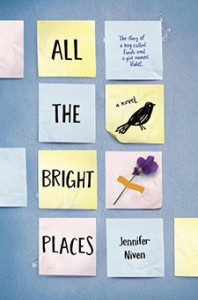Posted on February 19, 2015
“All The Bright Places”
By Jennifer Niven
By DONATELLA VACCA
A suicidal teen convincing a depressed girl that there is no point in killing herself is pretty contradictory, but it is precisely this contradiction and this teenage state of confusion that brings out the light and the lessons of “All The Bright Places.”
 As a cyclical novel that starts with despair, climaxes in joy and comes back to sadness again, Jennifer Niven’s story is a journey in which a suicidal boy, Theodore Finch, along with his troubled friend Violet Markey, explores all the brightest places that will prove there is indeed beauty in life and living.
As a cyclical novel that starts with despair, climaxes in joy and comes back to sadness again, Jennifer Niven’s story is a journey in which a suicidal boy, Theodore Finch, along with his troubled friend Violet Markey, explores all the brightest places that will prove there is indeed beauty in life and living.
Narrated from two alternating points of view, the story navigates the feelings and happenings of two typical teenagers trying to survive high school.
However, there is an unconventional catch: both of them are not sure if they want to be alive.
Standing on the ledge of the school tower wondering what it would feel like to jump, Finch discovers he has company and decides to stop Violet’s death assuming there is no reason for her to do it. But, she does have a reason and that’s where the story starts.
Just as Violet is given another chance, Finch becomes a hero that cannot be saved.
“All The Bright Places” is Jennifer Niven’s first book for young adult readers, and although the story is dark indeed, she succeeds in not only entertaining but also inculcating a message into the young community (either for the troubled, insecure, perfect or all). Even though her book is flooded by sadness and anguish, her idea is to let teenagers know that they are not alone in this world and that somehow there always is light at the end of the tunnel.
At the end of the authors’ note, she addresses the young readers directly and reassures them by saying: “You are not alone, it is not your fault and help is out there.” One of her character’s most iconic and inspiring phrases has to be: “It’s not what you take, it’s what you leave,” a phrase that although hard to comprehend it lingers for a while even after the pages are long read.
Having lost a close friend to suicide, Niven is no stranger to the drama and the sadness of deep emotional distress, writing in such a way that makes the reader wonder if she ever went through it herself.
For instance, at the beginning of the story there is a passage so well written and so emotionally deep that we wonder if she herself has ever experienced what Finch is going through first hand.
“It’s my experience that people are a lot more sympathetic if they can see you hurting […] and I wish for measles or smallpox […] some disease just to make it simple for me and also for them,” she writes.
It is amazing how she understands this feeling of hurting, but on the inside rather than on the outside. It is incredible how her words are so powerful that we get to understand what it really feels like to be hurting emotionally and psychologically.
Born in Indiana, Niven, a young writer, has already written non-fiction and four novels for adults known as “American Blonde,” “Becoming Clementine,” “Velva Jean Learns To Fly” and “Velva Jean Learns To Drive.” Although it is her first time exploring death and the teenage mind, she has done a great job of writing about, for and like the teenage generation.
Having won an Emmy for one of her short films, and having “All The Bright Places” picked up as the next cinematic adaptation before it was even released is enough evidence to prove Niven has what it takes.
Steered by drama, car accidents, bullying and death, Niven manages to incorporate sweet romance, star-crossed lovers style. Although it does sound unrealistic and cheesy, it is indeed this unexpected love what saves Violet and hopeless Finch, but not for too long.
Using a class project as an excuse, Finch takes Violet on a journey of rebirth, where she is able to eventually overcome her sister’s death and prevent hers. Through a series of different wanderings around Indiana, Finch teaches Violet the beauty that life has to offer, while still trying to figure out if he wants to be part of this beauty or not.
Consumed by a life of suffering, unhappiness, lack of affection and harming words (“Worthless. Stupid. Those are the words I grew up hearing.”) Finch’s death seems to be harder to avoid. Enlightened by Violet’s presence, he tries to live in the Awake but is constantly reminded of the dangers of slipping into the Asleep, known as the dark stages before death. “I will stay awake. I will not sleep.”
Sadly, the passion he has for saving Violet’s life is what consumes the passion for saving his own, plummeting him through darkness during the last chapters of the story.
However, this tremendous sadness is a drawback that might discourage and even bore readers towards the end. There is a point where Finch becomes so dramatic and pessimistic, that the storyline looses its pace for a while.
Although the plot is clear from the beginning, Niven likes to keep certain things under the covers and this is why her book will succeed in keeping readers hooked until the end. A master in mystery, she keeps us guessing what “accident” Violet talks about and what was it that scarred Finch so much into almost two thirds of the book.
Marked as Young Adult, the book succeeds in portraying teenage years. Niven writes with such emotion and perfection, that it feels as if she herself was an 18-year-old girl.
Knowing the teenage prototype and understanding the struggles of friendship, love, lust and gossip, she resorts to a specific tone and language that makes us feel back in high school all over again.
Niven captures the essence of teen spirit by saying things like: “They talk over each other in these high voices that always end in questions marks,” and “This is followed by laughter because we’re in high school, which means we’re predictable and almost anything is funny, especially if it’s someone else’s public humiliation.”
Not only does she represent the teenage voice with precision, but also makes the story very believable and contemporary by making references to current and existing TV shows, movies, places and people like Facebook, The Vampire Diaries and Emma Watson.
It is true that a story does feel much closer and tangible when things from the real world mingle with fiction.
Although part of the YA genre, Violet and Finch explore the dangerous world of drugs, alcohol, cigarettes and teen sex, something that might not be appropriate for readers under the age of 14.
It is clear that Niven is a book lover herself, because she constantly quotes famous writers like the Bronte sisters, Dr. Seuss, Virginia Woolf, Shakespeare and many others in her story, giving literature junkies something to like, if not adore.
Although Violet’s progress and Finch’s decay is consistent, the climax of the story seems to be a little rushed tempting the characters (and the readers) with a good scenario, but instead sending them in an emotional whirlwind that unfolds too quickly in the last three chapters.
Niven writes from Finch’s point of view as well as Violet’s. While Violet counts the days until graduation (or, as she calls it, “liberation”), Finch struggles to count the days he has been Awake. Then, towards the ending things take a sudden turn. As Finch fades away he stops counting the days, until his narration eventually disappears leaving Violet on her own with just a few wanderings to complete.
One of the best things about this dual narration is the fact that readers get Finch’s and Violet’s side of the story. Niven has a neat style of writing, and thus the flow of events is perfectly understandable. She has achieved great continuity between the alternating voices, making it easy to keep track of time and events.
Character development is on point, showing readers a progressive evolution from both Violet and Finch, who seem to be slowly reverting roles as the story continues. Violet starts as insecure and suicidal, and in an attempt to save her Finch ends up just like her but with no turning back. Although the characters grow to be better people, towards the last chapters Finch becomes stuck in some kind of behavioral black hole that turns annoying instead of sad.
A shocking, but predictable, ending will sadden most young readers, who will probably miss the point of the journey because of their devotion to the love story, which is definitely not the only thing to think about.
Although the ending is quite angering, it does go back to the beginning reminding us what Finch always wanted to do: save Violet.
Taking into consideration that the story starts with Finch thinking about killing himself, the ending is reasonable, appropriate and well written. However, it is probably not what the audience is rooting for, prompting possible disappointments from numerous readers.
Even though the conclusion deserved more time and dedication, Niven was successfully able to explore the uneasy realm of teenage years and death without writing a heartless story.
“All The Bright Places” is a dark but sweet story that explores death, guilt, suffering and loss all intertwined with the effects and the power of love and true friendship. Niven writes about very human things, like weaknesses and temptations and fears, so her novel is not just for teenagers but for everyone that has ever hit a bumpy road, expanding the YA horizons into a much bigger audience.
- “All The Bright Places”
- By Jennifer Niven
- Published on Jan. 6, 2015
- Publisher: Random House Children’s Books, printed in U.S.
- First edition
- Age range: young adults
- Length: 378 pages (plus extra content)
- Available in hardcover and eBook versions at any bookstore or the Internet.
- Extra content: author’s notes, acknowledgments, guide for suicide prevention centers & numbers, and about the author.
- Personal rating: 4½ stars out of 5

